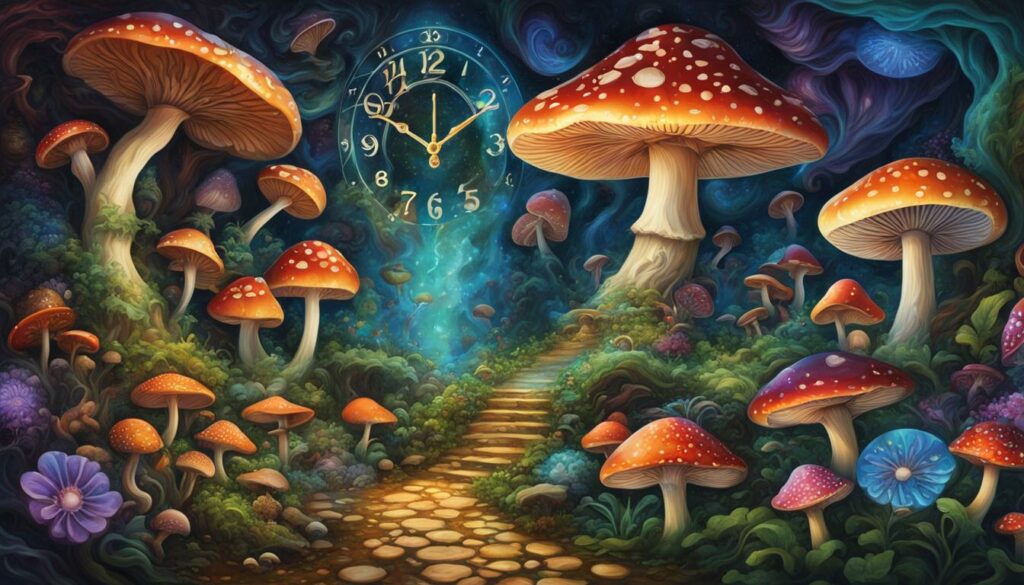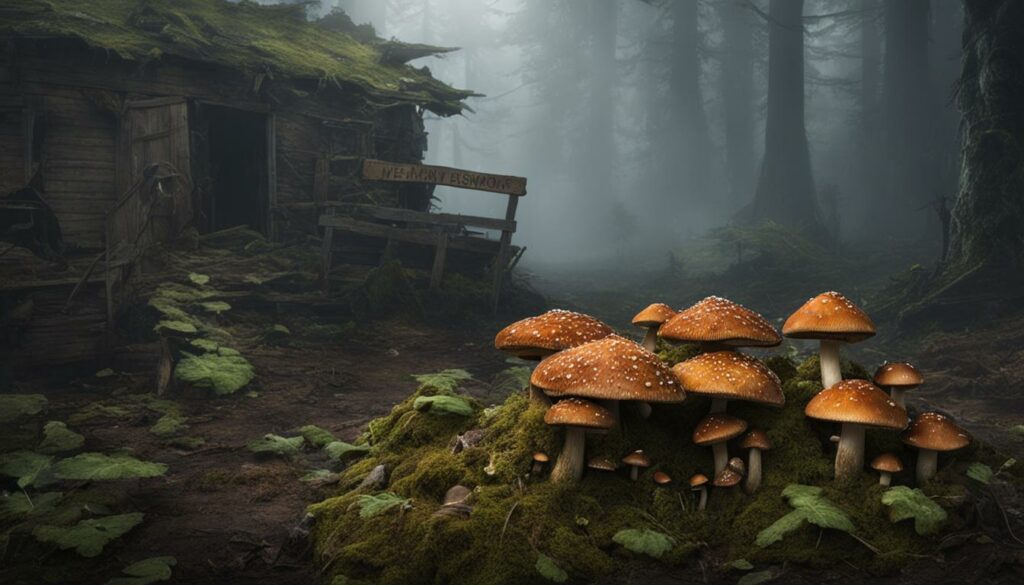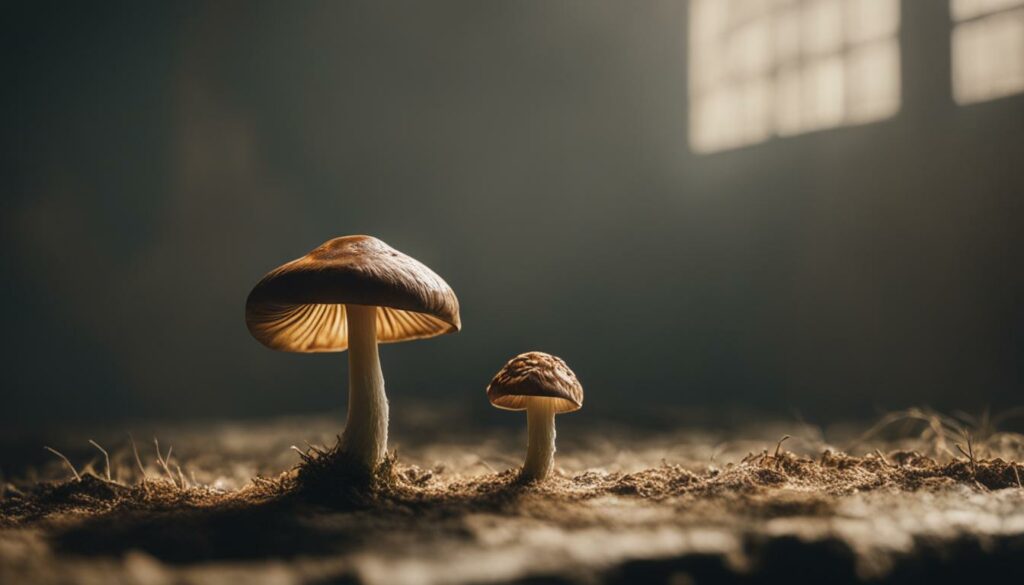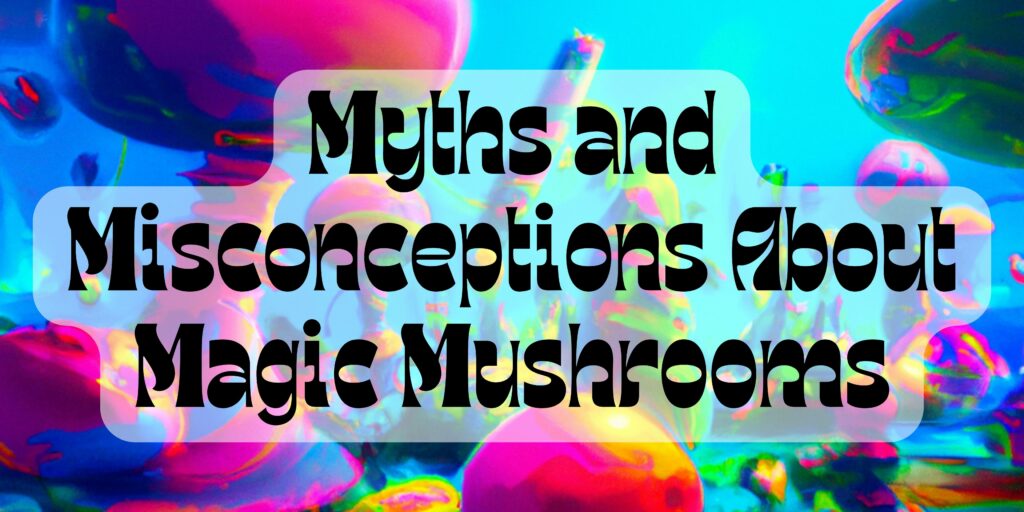Are you curious about the lifespan of magic mushrooms? Wondering if shrooms can expire and if mushrooms have an expiration date? In this article, we’ll explore these questions and more to help you better understand the shelf life and storage of your precious fungi.
Shrooms, also known as magic mushrooms, contain psilocybin or psilocin, chemicals that cause psychedelic hallucinations. The effects of shrooms last for three to six hours and include hallucinations, altered thinking, sense of time, and emotions. They are not physically addictive but can lead to psychological addiction. Improperly stored shrooms can pose health risks.
Key Takeaways:
- Shrooms, or magic mushrooms, contain psilocybin or psilocin.
- The effects of shrooms last for three to six hours.
- Improperly stored shrooms can pose health risks.
- Shrooms are not physically addictive but can lead to psychological addiction.
- Proper storage is important to maintain the quality and safety of shrooms.
What are Shrooms? How Do They Work?
Shrooms, also known as psilocybin mushrooms, are a type of fungi that contain the psychoactive compounds psilocybin and psilocin. When ingested, psilocybin is converted into psilocin in the body, which interacts with serotonin receptors in the brain, leading to altered perception, mood, and cognition.
The effects of shrooms can vary depending on various factors, including the dosage, individual physiology, and the setting in which they are consumed. Common effects include hallucinations, euphoria, changes in perception of time and space, heightened emotions, and altered thinking patterns.
It is important to note that the effects of shrooms are not solely subjective. Research has shown that psilocybin can produce lasting changes in the brain and have therapeutic potential for conditions such as depression, anxiety, and addiction.
“Psilocybin, the active compound in magic mushrooms, has been found to have profound effects on consciousness and may hold promise as a therapeutic tool.”
The Science Behind Shrooms
To understand how shrooms work, it’s essential to look at the chemical composition of psilocybin mushrooms. Psilocybin is rapidly converted to psilocin in the body, which primarily affects serotonin receptors in the brain, particularly the 5-HT2A receptor.
When psilocin binds to these receptors, it leads to altered communication between brain cells and changes in neural activity. This disruption in serotonin signaling is believed to be responsible for the various psychological effects of shrooms.
Research has shown that psilocybin can increase the connectivity and communication between different brain regions, leading to a “loosening” of the default mode network (DMN), a network associated with self-referential thinking and the ego. This loosening of the DMN is thought to underlie the ego-dissolving and mystical experiences often reported by individuals who consume shrooms.
Types of Psilocybin Mushrooms
| Species | Common Name | Potency |
|---|---|---|
| Panaeolus cyanescens | Blue Meanies | High |
| Panaeolus tropicalis | Gold Caps | Moderate |
| Psilocybe cubensis | Golden Teacher | Moderate to High |
| Psilocybe semilanceata | Liberty Caps | Moderate |
| Psilocybe mexicana | Teonanácatl | Low to Moderate |
These are just a few examples of the many species of psilocybin mushrooms found in nature. Each species can vary in terms of potency, visual characteristics, and the effects produced.
- Blue Meanies (Panaeolus cyanescens) are known for their high psilocybin content and intense visual hallucinations.
- Golden Teacher (Psilocybe cubensis) is a popular choice due to its moderate to high potency and a range of visual and introspective effects.
- Teonanácatl (Psilocybe mexicana) is one of the oldest known species of psilocybin mushrooms and is associated with ancient Mesoamerican cultures.
It’s important to note that the potency of psilocybin mushrooms can vary even within the same species, depending on factors such as growing conditions and genetics. Always exercise caution and start with a low dose when consuming shrooms.
Duration and Effects When Consumed
When it comes to consuming shrooms, understanding the duration and effects is crucial for a safe and enjoyable experience. Most individuals start feeling the effects of shrooms approximately 30 minutes after ingestion. These effects can last anywhere from three to six hours, with the first three to four hours being the most intense.
It’s important to note that the duration and intensity of the effects can vary among individuals. Factors such as dosage, surroundings, tolerance, and individual mood can influence the overall experience. Some individuals may also experience delayed headaches, exhaustion, or depression after the effects wear off.
To better understand the timeline of shroom consumption, below is a breakdown of the typical duration:
| Time | Effects |
|---|---|
| 0-30 minutes | Onset of effects, mild sensations |
| 30 minutes – 1.5 hours | Increase in intensity, hallucinations, altered thinking |
| 1.5 – 3 hours | Peak effects, heightened emotions, sense of time distortion |
| 3 – 6 hours | Effects gradually subside |
It’s worth mentioning that the effects of shrooms can be profound and may impact an individual’s perception of reality. It’s essential to approach shroom consumption with caution, in a safe and comfortable environment, and with trusted companions.
Factors Influencing Duration and Intensity
When it comes to the duration and intensity of shroom effects, several factors come into play. Understanding these factors can help enhance your shroom experience and make the most of your journey.
1. Dosage:
The amount of shrooms consumed directly affects the intensity and duration of the trip. Higher doses typically lead to more intense and longer-lasting effects, while lower doses may result in a milder experience.
2. Set and Setting:
Your mindset and the environment in which you take shrooms can greatly impact your experience. Being in a comfortable and safe setting, surrounded by supportive and trustworthy individuals, can enhance the positive effects of shrooms. Conversely, a stressful or unpredictable environment may lead to anxiety or a challenging trip.
3. Tolerance:
Regular use of shrooms can build tolerance, meaning you may need higher doses to achieve the same effects over time. It is important to take breaks between trips to allow your tolerance to reset, ensuring a more impactful experience.
4. Personal Physiology:
Every individual reacts differently to shrooms, and factors such as body weight, metabolism, and overall health can influence how your body processes psilocybin. It is essential to start with a low dose and gradually increase if needed, as everyone’s reaction can vary.
5. Interaction with Medications:
If you are taking medications, it is crucial to research potential interactions with psilocybin. Certain medications, such as antidepressants or antipsychotics, may interact negatively with shrooms, leading to unpredictable effects or health risks.
| Factors Influencing Shroom Effects | How to Enhance Shroom Experience |
|---|---|
| Dosage | Start with a lower dose and gradually increase if desired. Remember, higher doses can lead to more intense effects. |
| Set and Setting | Create a comfortable, safe, and supportive environment. Surround yourself with trusted individuals who can provide a positive trip atmosphere. |
| Tolerance | Take breaks between trips to allow your tolerance to reset. This will ensure that you can achieve the desired effects without needing higher doses. |
| Personal Physiology | Understand that each person’s reaction to shrooms is unique. Start with a conservative dose and adjust accordingly based on your personal experience. |
| Interaction with Medications | Research potential interactions between psilocybin and any medications you are taking. Consult with a healthcare professional if you have any concerns. |
By considering these factors and taking the necessary precautions, you can have a more enjoyable and meaningful shroom experience. Remember to always prioritize safety, educate yourself about the risks, and approach shrooms with respect and mindfulness.

Shelf Life and Storage of Shrooms
Proper storage is crucial when it comes to preserving the quality and potency of magic mushrooms. Whether you have freshly harvested mushrooms or dried ones, understanding the shelf life and best storage practices is essential to ensure a safe and enjoyable experience.
How Long Do Shrooms Last?
Freshly harvested mushrooms that have not been properly dried or exposed to moisture can quickly decay and become unsafe to consume. These mushrooms should ideally be consumed within a week of harvesting to avoid spoilage and potential health risks.
On the other hand, properly dried magic mushrooms can last much longer. When stored in a cool, dark place, dried shrooms can maintain their potency for up to 12 months. However, it’s important to note that over time, the mushrooms may gradually lose some of their potency. Therefore, it’s always best to consume dried shrooms within a year for the maximum desired effects.
Storing Magic Mushrooms
Properly storing magic mushrooms is crucial to maintain their quality and extend their shelf life. Here are some tips to ensure your shrooms stay fresh:
- Dry the shrooms thoroughly: Before storing mushrooms, make sure they are completely dry. Moisture can lead to mold growth and spoilage.
- Use an airtight container: Place the dried mushrooms in an airtight container to prevent moisture from seeping in. Mason jars or vacuum-sealed bags are excellent options.
- Keep in a cool and dark place: Store the container in a cool, dark area like a pantry or cabinet. Excessive heat and light can degrade the potency of the mushrooms.
- Avoid exposure to oxygen: Oxygen can cause oxidation, which can degrade the quality of the mushrooms. Vacuum-sealing or using oxygen absorbers can help minimize oxygen exposure.
Following these storage guidelines will help preserve the potency and quality of your magic mushrooms, ensuring a more enjoyable and satisfying psychedelic experience.
| Storage Method | Shelf Life | Potency Retention |
|---|---|---|
| Fresh Shrooms (unrefrigerated) | Up to 1 week | N/A |
| Dried Shrooms (stored in airtight container) | Up to 12 months | Gradual loss over time |
| Frozen Shrooms (stored in airtight container) | Several years | Minimal potency loss |
Risks and Safety Concerns When Using Shrooms
Consuming expired shrooms can pose various risks and safety concerns. It is important to be aware of the potential effects of eating expired mushrooms and the dangers of shroom overdose.
Risks of Consuming Expired Shrooms
Expired shrooms may lose their potency and effectiveness. The chemical composition of psilocybin mushrooms can change over time, causing a decrease in psychoactive effects. This means that consuming expired shrooms may not produce the desired hallucinogenic experience.
In addition to decreased potency, expired shrooms can also lead to unwanted side effects. Depending on the level of decay and decomposition, consuming expired mushrooms can cause gastrointestinal issues such as nausea, vomiting, and diarrhea. These physical symptoms can be uncomfortable and can potentially ruin the overall experience.
Dangers of Shroom Overdose
While shrooms are generally considered safe when consumed in moderate doses, taking excessive amounts can lead to a shroom overdose. Symptoms of a shroom overdose can include intense anxiety, paranoia, confusion, hallucinations, seizures, and even coma. It is important to be cautious and mindful of the dosage to avoid any potential dangers.
Furthermore, shrooms can have negative effects on mental health, especially for individuals with pre-existing conditions. Those with a history of mental illness or psychiatric disorders should exercise caution when considering the use of shrooms. The psychedelic properties of shrooms can amplify emotions and thoughts, potentially exacerbating existing mental health issues.

| Risks of Consuming Expired Shrooms | Dangers of Shroom Overdose |
|---|---|
| Decreased potency and effectiveness | Intense anxiety and paranoia |
| Unwanted side effects such as nausea and vomiting | Confusion and hallucinations |
| Seizures and coma |
Legal Status
The legal status of shrooms varies from country to country and within different regions. In the United States, shrooms are classified as a Schedule I controlled substance at the federal level, making their possession, cultivation, and distribution illegal. However, there are ongoing efforts to change these laws, particularly in relation to the therapeutic potential of psilocybin mushrooms.
Several municipalities in Michigan, Massachusetts, Colorado, California, and Washington have decriminalized or legalized the use of shrooms to varying degrees. For example, Denver, Colorado, decriminalized the possession and use of psilocybin mushrooms for personal consumption in 2019. In California, the cities of Santa Cruz and Oakland have also decriminalized the possession and cultivation of shrooms for personal use.
One of the most progressive moves towards the legal status of shrooms has been in Oregon, where Measure 109 was passed in November 2020. This measure allows for the regulated medical use of psilocybin, with a focus on providing therapy for mental health conditions. This opens up possibilities for research and potential therapeutic applications in the state.
Table: Legal Status of Shrooms (United States)
| State | Status |
|---|---|
| Michigan | Decriminalized |
| Massachusetts | Decriminalized |
| Colorado | Decriminalized |
| California | Decriminalized |
| Washington | Decriminalized |
| Oregon | Legal for regulated medical use |
The decriminalization and legalization of shrooms in these regions are driven by a growing body of research suggesting that psilocybin may have therapeutic benefits for conditions such as depression, anxiety, and addiction. However, it is important to note that despite these local changes, shrooms remain illegal at the federal level in the United States.
Conclusion
Proper storage is crucial when it comes to maintaining the quality and safety of shrooms. Fresh shrooms should be consumed within a week to avoid decay and potential health risks. On the other hand, dried shrooms can last up to a year if stored in a cool, dark place, although their potency may diminish over time.
Expired shrooms can lead to unwanted side effects and may not provide the desired psychedelic experience. It is important to be mindful of the risks and safety concerns associated with shroom use, such as the potential for poisoning and physical symptoms like nausea and headaches.
Furthermore, it is essential to consider the potential negative effects on mental health, especially for individuals with pre-existing conditions. Responsible use and being aware of one’s own limits are crucial to avoiding psychological addiction and promoting overall well-being.
The legal status of shrooms varies across regions, with some jurisdictions decriminalizing or legalizing them for specific purposes. Efforts are underway to explore potential therapeutic benefits in treating conditions such as depression, anxiety, and addiction.
FAQ
Can shrooms expire?
Yes, shrooms can expire. Fresh shrooms should be consumed within a week, while dried shrooms can last up to a year.
Do mushrooms have an expiration date?
Yes, mushrooms, including shrooms, can expire if not stored properly. Proper storage is essential to maintain their quality and safety.
How long do mushrooms last?
Fresh shrooms should be consumed within a week, while dried shrooms can last up to a year if stored correctly.
What are shrooms?
Shrooms, also known as magic mushrooms, refer to a group of fungi containing psilocybin, a chemical that causes psychedelic effects when ingested.
How do shrooms work?
When ingested, psilocybin in shrooms is converted into psilocin, which causes the psychedelic effects such as hallucinations and altered thinking.
What is the duration of shroom effects?
The effects of shrooms can last between three and six hours, with the first three to four hours being the most intense.
What happens when you take shrooms?
When you take shrooms, you may experience hallucinations, euphoria, headaches, nausea, confusion, and anxiety.
What factors influence the duration and intensity of shroom effects?
Factors such as dosage, surroundings, tolerance, and individual mood can influence the duration and intensity of shroom effects.
How can you enhance the shroom experience?
The shroom experience can be influenced by factors such as an empty stomach, the surrounding environment, mood, and companions. Being in a comfortable and safe setting is important.
How long do shrooms last if stored properly?
Dried shrooms stored in a cool, dark place can last up to a year, but they may lose potency over time. Frozen shrooms can last for several years without losing potency.
What are the risks of consuming expired shrooms?
Consuming expired shrooms can pose health risks, such as nausea, headaches, dizziness, and diarrhea. There is also a risk of poisoning if you consume the wrong mushroom, as many varieties are poisonous.
What are the effects of eating expired mushrooms?
Eating expired mushrooms, including shrooms, can cause unwanted physical symptoms and may lead to shroom overdose, which can result in symptoms such as anxiety, psychosis, seizures, and coma.
What are the dangers of shroom overdose?
Shroom overdose can lead to symptoms such as anxiety, psychosis, seizures, and coma. It is important to consume shrooms responsibly and in moderation.
Do shrooms have negative effects on mental health?
Shrooms can have negative effects on mental health, especially for those with pre-existing conditions. Regular use can also lead to psychological addiction.
What is the legal status of shrooms?
Shrooms are illegal at the federal level in the United States, but certain municipalities in Michigan, Massachusetts, Colorado, California, and Washington have decriminalized or legalized them to varying degrees. Oregon has fully decriminalized them.
There are ongoing efforts to change the legal status of shrooms due to their potential therapeutic benefits in treating conditions such as depression, anxiety, and addiction.
Q: What is the conclusion about shroom expiration, lifespan, and storage?
Proper storage is essential to maintain the quality and safety of shrooms. Fresh shrooms should be consumed within a week, while dried shrooms can last up to a year. Expired shrooms may lose potency and can cause unwanted side effects. It is important to be aware of the risks and safety concerns when using shrooms, including the potential for poisoning, physical symptoms, and negative effects on mental health. Legal status varies, with some regions decriminalizing or legalizing shrooms. Overall, responsible use and proper storage are key to a positive shroom experience.




